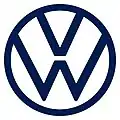Volkswagen Sharan
The Volkswagen Sharan is a multi-purpose vehicle (MPV) produced by the German Volkswagen Group and built at the AutoEuropa plant in Palmela, Portugal, since 1995. Through badge engineering, the Volkswagen Sharan shares the same platform with the SEAT Alhambra, and the first generation was also in most respects identical to the Ford Galaxy. Since 2010, the Sharan is in its second generation.
| Volkswagen Sharan | |
|---|---|
 | |
| Overview | |
| Manufacturer | Volkswagen |
| Production | 1995–present 2001–2015 (Argentina) |
| Assembly | Portugal: Palmela (AutoEuropa) |
| Body and chassis | |
| Class | Mid-size MPV (M) |
| Body style | 5-door MPV |
| Layout | Front-engine, front-wheel-drive |
| Chronology | |
| Successor | Volkswagen Viloran (China) |
First generation (Typ 7M; 1995)
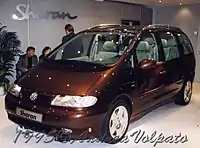
| First generation (7M) | |
|---|---|
 | |
| Overview | |
| Also called | Ford Galaxy SEAT Alhambra |
| Production | 1995–2010 |
| Assembly | Portugal: Palmela (AutoEuropa) |
| Designer | Greg M Greeson (1990) |
| Body and chassis | |
| Platform | Volkswagen Group B-VX62 |
| Powertrain | |
| Engine | Petrol: 1.8L I4 110 kW (148 hp) 20V Turbo 2.0L I4 85 kW (114 hp) 2.8L VR6 128 kW (172 hp) 2.8L VR6 150 kW (201 hp) 24V Diesel: 1.9L I4 66 kW (89 hp) TDI 1.9L I4 81 kW (109 hp) TDI 1.9L I4 85 kW (114 hp) TDI 1.9L I4 96 kW (129 hp) TDI 1.9L I4 110 kW (148 hp) TDI 2.0L I4 103 kW (138 hp) TDI |
| Transmission | |
| Dimensions | |
| Wheelbase | Pre-Facelift & 2010–: 2,835 mm (111.6 in) 2004–09: 2,841 mm (111.9 in) |
| Length | Pre-Facelift: 4,620 mm (181.9 in) Facelifted: 4,634 mm (182.4 in) |
| Width | Pre-Facelift: 1,810 mm (71.3 in) Facelifted: 1,810 mm (71.3 in) |
| Height | Pre-Facelift: 1,762 mm (69.4 in) 2004–09: 1,759 mm (69.3 in) 2010–: 1,732 mm (68.2 in) |
The Sharan was the Volkswagen-badged product from a joint venture between Volkswagen and Ford Motor Company to produce vehicles in the increasingly important MPV market, which was filled at the time by Renault's Espace and Chrysler's Voyager.[1] The resulting Volkswagen Sharan concept (and Ford Galaxy) was shown at the 1994 Paris Auto Show,[2] and production started in May 1995. The name Sharan is derived from a Persian word meaning "Carrier of Kings". In the United Kingdom, the name was often mocked for sounding similar to a popular Essex girl's name "Sharon".[3][4]
The Volkswagen Group subsequently rebadged the Sharan and sold it as the SEAT Alhambra alongside the Sharan. All variants were produced at the joint venture's plant AutoEuropa in Portugal, alongside the closely related Ford Galaxy. The Sharan was on sale from 1995 to 2010, accompanied with facelifts in 2000 and 2004.[5]
As of 2007, the annual production for the Sharan is in the 50,000 unit range; it is sold in Europe, South Africa and some Asia Pacific and Latin American countries. In Mexico, it was available with the 1.8L Turbo 4 cil 150 hp (112 kW) with five speed Tiptronic automatic gearbox in Comfortline trim only, while in Argentina it is available with the 1.8L Turbo and the 1.9L TDI 115 hp four cylinder engines, in both five speed manual and five speed Tiptronic transmissions in Trendline trim only.
The cooperation between Volkswagen and Ford ended in 2006, with the latter going alone in building the second generation Galaxy.
The Sharan was not sold in the United States and Canada. Originally, this was due to an agreement between Ford and Volkswagen, leaving the market free from competition for Ford's Aerostar minivan. Volkswagen later decided not to introduce the Sharan in North America, ceased developing the Microbus concept, and instead introduced a badge-engineered variant of the Chrysler minivans as the Routan. This was launched in 2009, and replaced the Sharan in Mexico which was the only North American country where the Sharan was sold.
Scoring 200 points on the United Kingdom Reliability Index, the Sharan is considered very unreliable when compared to the average vehicle score of 100, while a very reliable vehicle scores 60 or below. The average age and repair cost of the tested Sharan was 5,3 years and covered 63,546 miles.[6] It has been noted that, despite enjoying high popularity,[7] the Sharan has consistently performed poorly in UK customer satisfaction surveys,[8] including a last place 138th in a 2003 survey.[9] Although quality problems existed in the original version, the Sharan quickly became the best selling MPV in Germany.[10] It also sold better there than the technically identical SEAT Alhambra and Ford Galaxy despite costing up to 2500 euros more.[11]
The first generation Volkswagen Sharan was on sale for over 15 years[12] having been built almost unchanged during the time. By the time it was replaced in 2011 it was one of the longest running car models in Europe.[13] Despite its age, nearly 24,000 Sharans were still being sold annually as of 2008.[14] In total, Volkswagen sold almost 670,000 units of its Sharan.
Mark 1/Phase 1 (1995–2000)

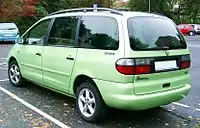
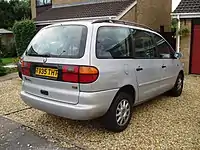
The original Sharan was launched in August 1995, and was available with five engine choices:
| Model | Years | Engine and code | Displ. | Power | Torque | |
|---|---|---|---|---|---|---|
| 1.8T | 1997–2000 | I4 20V | AJH | 1781 cc | 110 kW (150 PS; 148 hp) @ 6000 rpm | 210 N⋅m (155 lb⋅ft) @ 1750–4600 rpm |
| 2.0 | 1995–2000 | I4 8V | ADY | 1984 cc | 85 kW (116 PS; 114 hp) @ 5000 rpm | 170 N⋅m (125 lb⋅ft) @ 2400 rpm |
| 2.8 VR6* | 1995–2000 | VR6 24V | AAA/AMY | 2792 cc | 128 kW (174 PS; 172 hp) @ 5800 rpm | 235 N⋅m (173 lb⋅ft) @ 4200 rpm |
| 1.9 TDI | 1995–2000 | I4 8V | 1Z/AHU | 1896 cc | 66 kW (90 PS; 89 hp) @ 4000 rpm | 202 N⋅m (149 lb⋅ft) @ 1900 rpm |
| 1.9 TDI | 1996–2000 | I4 8V | AFN/AVG | 1896 cc | 81 kW (110 PS; 109 hp) @ 4150 rpm | 235 N⋅m (173 lb⋅ft) @ 1900 rpm |
*The 2.8 VR6 model had the option of Syncro all-wheel drive.
The design and technology of the Sharan (including Alhambra and Galaxy) was a mix between both Volkswagen and Ford. The design was a compromise solution, with the front looking similar to a Ford Mondeo Mk1 and the rear like Volkswagen Passat (B4). Each of the three MPV models had its own subtle differences in exterior, and, for the Galaxy, in interior design. The first generation's initial design was completed under Greg M Greeson, an American designer employed in Volkswagen's Advanced Design Studio in Düsseldorf, West Germany from 1989 to 1990.
Some small visual changes in 1998 included new door wings derived from the Volkswagen Golf Mk4 and some changes in the dashboard.
The Sharan received a EuroNCAP three star safety rating when it was tested in 1999.[15]
Awards
- 1999 Auto Express New Car Honours – Best MPV
- 1998 Top Gear Magazine Top Cars – Best People Carrier (Joint Winner)
- 1996 What Car Awards – Best People Carrier (Joint Winner)
- 1996 Auto Express Awards – Best People Carrier (Joint Winner)
Mark 1A/Phase 1.5 (2000–2004)
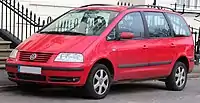
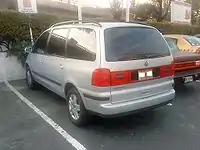
The Sharan and its stablemates received a major facelift in May 2000. At this time, Volkswagen also extended the wheelbase by 6 mm (0.2 in), increased the front and rear track, and gave it the "Volkswagen family" look of the time including a brand new dashboard no longer sourced from Ford. Seven seats now came as standard.[16]
Awards
- 2000 Auto Express New Car Honours – Best MPV
Engines
| Model | Years | Engine and code | Displ. | Power | Torque | |
|---|---|---|---|---|---|---|
| 1.8T | 2000–2004 | I4 20V | AWC | 1781 cc | 110 kW (150 PS; 148 hp) @ 5800 rpm | 220 N⋅m (162 lb⋅ft) @ 1800 rpm |
| 2.0 | 2000–2004 | I4 8V | ATM | 1984 cc | 85 kW (116 PS; 114 hp) @ 5200 rpm | 170 N⋅m (125 lb⋅ft) @ 2600 rpm |
| 2.8 VR6 | 2000–2004 | VR6 24V | AYL | 2792 cc | 150 kW (204 PS; 201 hp) @ 6200 rpm | 265 N⋅m (195 lb⋅ft) @ 3400 rpm |
| 1.9 TDI* | 2000–2003 | I4 8V | ANU | 1896 cc | 66 kW (90 PS; 89 hp) @ 4000 rpm | 240 N⋅m (177 lb⋅ft) @ 1900 rpm |
| 1.9 TDI | 2000–2005 | I4 8V | AUY | 1896 cc | 85 kW (116 PS; 114 hp) @ 4000 rpm | 310 N⋅m (229 lb⋅ft) @ 1900 rpm |
| 1.9 TDI | 2003–2007 | I4 8V | ASZ | 1896 cc | 96 kW (131 PS; 129 hp) @ 4000 rpm | 310 N⋅m (229 lb⋅ft) @ 1900 rpm |
*Available option - 4motion AWD with 6 speed manual transmission
Mark 1B/Phase 1.75 (2004–2010)
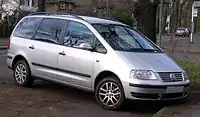
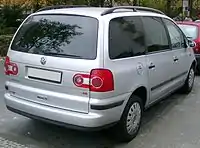
A further minor cosmetic facelift was implemented in September 2003 for the model year of 2004. This changed, primarily, the grille, and tail lights (round). Also, more standard equipment was added, including air conditioning and curtain side air bags. In 2006, Ford independently introduced a new Galaxy which was not based on the Sharan and Alhambra designs from the Volkswagen Group.
The new Galaxy was built at a dedicated Ford plant in Limburg, Belgium. The last first generation Ford Galaxy rolled off the AutoEuropa line at the end of 2005, while the first generation Sharan and SEAT Alhambra continued in production, alongside the Volkswagen Eos and the new Scirocco, until August 2010.
A BlueMotion variant was introduced in 2008 and went on sale in Germany in May 2008, with lower (159g/km) CO2 emissions and average fuel consumption of 38 mpg U.S.[17] In the UK only 60 BlueMotions were expected to shift per year,[18] and it was on sale there until February 2011.
Engines
| Model | Years | Engine and code | Displ. | Power | Torque | |
|---|---|---|---|---|---|---|
| 1.8T | 2003–2005 | I4 20V | AWC | 1781 cc | 110 kW (150 PS; 148 hp) @ 5800 rpm | 220 N⋅m (162 lb⋅ft) @ 1800 rpm |
| 2.0 | 2003–2007 | I4 8V | ATM | 1984 cc | 85 kW (116 PS; 114 hp) @ 5200 rpm | 170 N⋅m (125 lb⋅ft) @ 2600 rpm |
| 2.8 VR6 | 2003–2008 | VR6 24V | AYL | 2792 cc | 150 kW (204 PS; 201 hp) @ 6200 rpm | 265 N⋅m (195 lb⋅ft) @ 3400 rpm |
| 1.9 TDI | 2006–2010 | I4 8V | BVK | 1896 cc | 85 kW (116 PS; 114 hp) @ 4000 rpm | 310 N⋅m (229 lb⋅ft) @ 1900 rpm |
| 1.9 TDI | 2003–2007 | I4 8V | ASZ | 1896 cc | 96 kW (131 PS; 129 hp) @ 4000 rpm | 310 N⋅m (229 lb⋅ft) @ 1900 rpm |
| 1.9 TDI | 2003–2009 | I4 8V | BTB | 1896 cc | 110 kW (150 PS; 148 hp) @ 4000 rpm | 320 N⋅m (236 lb⋅ft) @ 1900 rpm |
| 2.0 TDI | 2006–2010 | I4 8V | BRT | 1968 cc | 103 kW (140 PS; 138 hp) @ 4000 rpm | 310 N⋅m (229 lb⋅ft) @ 1900 rpm |
LPG version
In June 2006, PrinceGas[19] and Volkswagen launched the Sharan with a 2.0 L 85 kW (114 hp) flexible fuel engine, which could work with either petrol or autogas (liquified petroleum gas), providing an additional 450 km (280 mi) range over the regular 2.0L petrol engine. Both fuel tanks, the 70L (18 US gallon) petrol tank and the 60L liquid gas tank combined, give the Sharan enough fuel to cover 730 km (454 mi) between refuels at an average fuel consumption of 9.6 L/100 km.[19]
The liquid gas tank is built into the spare wheel well so it does not compromise on passenger and loading space of the Sharan's interior, although it does eliminate the spare tyre.
Second generation (Typ 7N; 2010)
| Second generation (7N) | |
|---|---|
 | |
| Overview | |
| Also called | SEAT Alhambra |
| Production | 2010–present |
| Assembly | Portugal: Palmela (AutoEuropa) |
| Body and chassis | |
| Platform | Volkswagen Group A6 PQ46 |
| Related | Volkswagen Passat B7 |
| Powertrain | |
| Engine | Petrol engines: 1.4L 110 kW (148 hp) TSI 2.0L 147 kW (197 hp) TSI Diesel engines: 2.0L 103 kW (138 hp) TDI 2.0L 125 kW (168 hp) TDI |
| Transmission | |
| Dimensions | |
| Wheelbase | 2,920 mm (115.0 in) |
| Length | 4,850 mm (190.9 in) |
| Width | 1,924 mm (75.7 in) |
| Height | 1,810 mm (71.3 in) |
The second generation Sharan, based on the Volkswagen Passat (B7), was launched at the 2010 Geneva Motor Show[20] and a month later, the second generation of its sibling model, the SEAT Alhambra, was officially announced.[21] Sales commenced in September 2010.
Although still built at the AutoEuropa factory in Portugal, the new model inherits only its name from the previous Sharan,[22] compared to which it is 220 mm (8.7 in) longer, 92 mm (3.6 in) wider and 12 mm (0.5 in) lower, with the wheelbase lengthened by 75 mm (3.0 in).
Weight has been reduced by 30 kg (66 lb). The initial engine range comprises 1.4 litre TSI (148 bhp) and 2.0-litre (197 bhp) petrol options, plus two 2.0 litre TDI diesel engines, rated at 140 PS (103 kW; 138 hp) and 168 bhp (125 kW; 170 PS). The rear doors now slide open rather than being hinged.[22]
Gallery
.jpg.webp) Volkswagen Sharan 2.0 TSI (Malaysia)
Volkswagen Sharan 2.0 TSI (Malaysia)_front.JPG.webp) Volkswagen Sharan TSI Comfortline BlueMotion (Japan)
Volkswagen Sharan TSI Comfortline BlueMotion (Japan)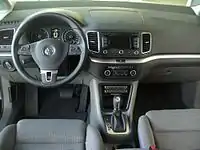 Interior
Interior
Facelift

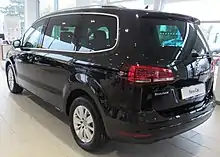
At the 2015 Geneva Motor Show, a facelifted Sharan was unveiled to the public. It has new electronic systems and engines with reduced fuel consumption.[23] Its 2.0 litre TSi engine (220 PS (217 hp; 162 kW), 350 N⋅m (258 lb⋅ft)) and six speed direct-shift gearbox are the same as in the 2016 Golf GTi.
As public service vehicles
 Mark 1 Sharan as a fire engine in Elmstein, Germany
Mark 1 Sharan as a fire engine in Elmstein, Germany Mark 1A Sharan in use as a paramedic vehicle in Roskilde, Denmark
Mark 1A Sharan in use as a paramedic vehicle in Roskilde, Denmark.jpg.webp) Mark 1A Sharan from Stuttgart, Germany police
Mark 1A Sharan from Stuttgart, Germany police Mark 1B Sharan as a taxi in Germany
Mark 1B Sharan as a taxi in Germany Mark 1B Sharan from Porto, Portugal police
Mark 1B Sharan from Porto, Portugal police Sharan as a Portuguese traffic control vehicle
Sharan as a Portuguese traffic control vehicle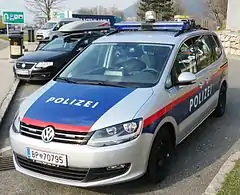 Mark 2 Sharan as a police vehicle in Austria
Mark 2 Sharan as a police vehicle in Austria Mark 2 Sharan as a taxi in Sweden
Mark 2 Sharan as a taxi in Sweden
References
- https://www.pkw.de/ratgeber/specials/vw-sharan
- https://www.motortrend.com/news/1994-paris-auto-show-2/
- https://www.birminghammail.co.uk/motoring/car-reviews/vw-last-laugh-popular-sharan-11618046
- http://home.bt.com/lifestyle/motoring/motoring-features/the-worst-car-names-ever-11363884166878
- https://www.carzone.ie/reviews/used-car-buying-guides/Volkswagen/Sharan/1995-2010/335/
- "Car Reliability Search Results". Retrieved 15 January 2014.
- https://www.birminghammail.co.uk/motoring/car-reviews/vw-last-laugh-popular-sharan-11618046
- https://www.honestjohn.co.uk/carbycar/volkswagen/sharan-1995/#
- https://www.telegraph.co.uk/motoring/news/2721781/Honda-Logo-tops-car-survey.html
- https://www.pkw.de/ratgeber/specials/vw-sharan
- Langner, Tobias (9 March 2013). Integriertes Branding: Baupläne zur Gestaltung erfolgreicher Marken. ISBN 9783322914446.
- https://www.autoexpress.co.uk/car-reviews/14379/seven-seat-mpv-shoot-out
- https://www.aol.co.uk/2010/02/23/vw-teases-with-new-sharan
- https://www.derwesten.de/auto/der-sharan-laeuft-und-laeuft-und-laeuft-id831813.html
- https://www.euroncap.com/en/ratings-rewards/latest-safety-ratings/en/results/vw/sharan/15510
- https://www.rac.co.uk/drive/car-reviews/volkswagen/sharan/sharan-2000-2010/
- https://www.autoblog.com/2008/05/02/vw-sharan-bluemotion-already-on-sale-in-germany
- https://www.autocar.co.uk/car-review/volkswagen/sharan/first-drives/volkswagen-sharan-bluemotion
- "The VW Gazette: Ecology Meets Economy". Vwgazette.blogspot.com. 2006-06-20. Retrieved 2011-06-25.
- "Geneva motor show: VW Sharan". Autocar. 2 March 2010. Archived from the original on 2 March 2010. Retrieved 4 March 2010.
- "The new Alhambra – highly functional and efficient perfect for the active family". SEAT. 2010-04-19. Archived from the original on 23 February 2012. Retrieved 19 April 2010.
- "Genfer Autosalon". Auto Motor u. Sport. Vol. 2010 07. 11 March 2010. pp. 32–36.
- "Show premiere of the Sharan in Geneva". Volkswagen Media. Volkswagen AG. 2015-02-18. Retrieved 2015-02-25.
External links
| Wikimedia Commons has media related to Volkswagen Sharan. |
- VW Sharan Website
- SEAT Alhambra official website
- EuroNCAP test of the 1999 Volkswagen Sharan
- EuroNCAP test of the 2010 Volkswagen Sharan
